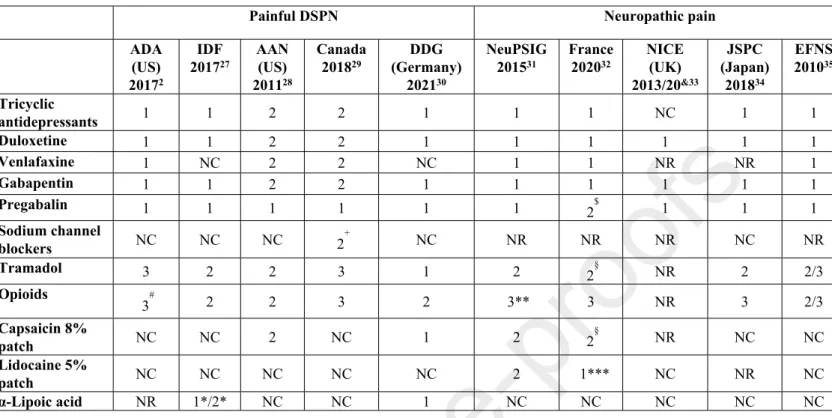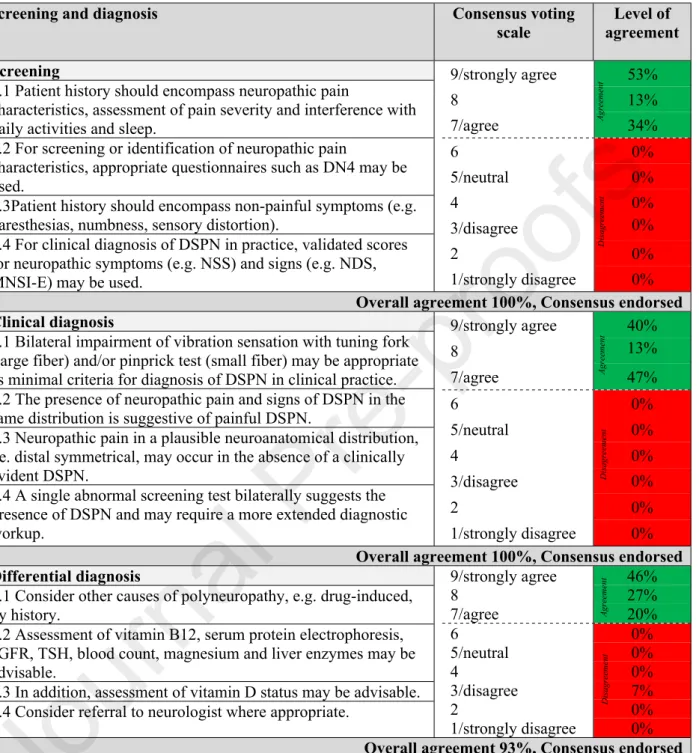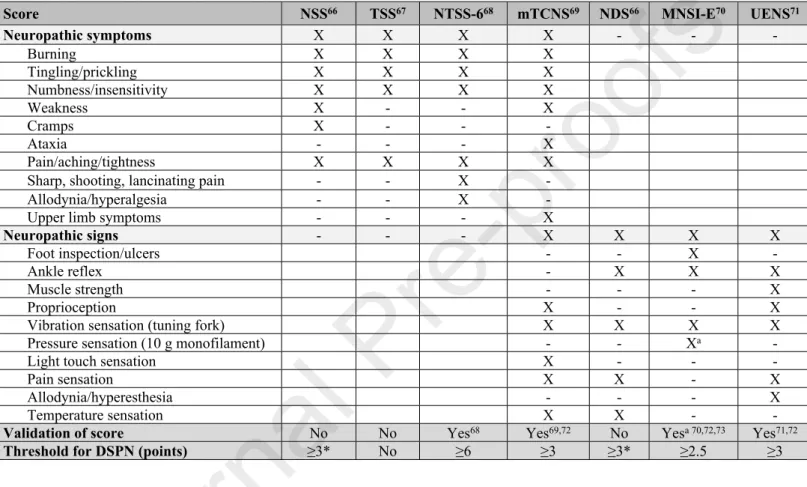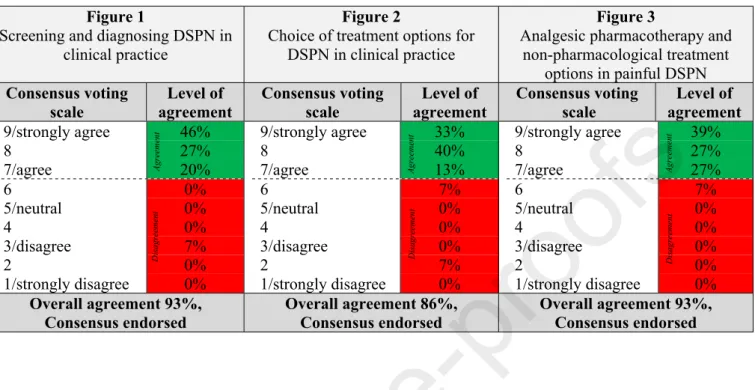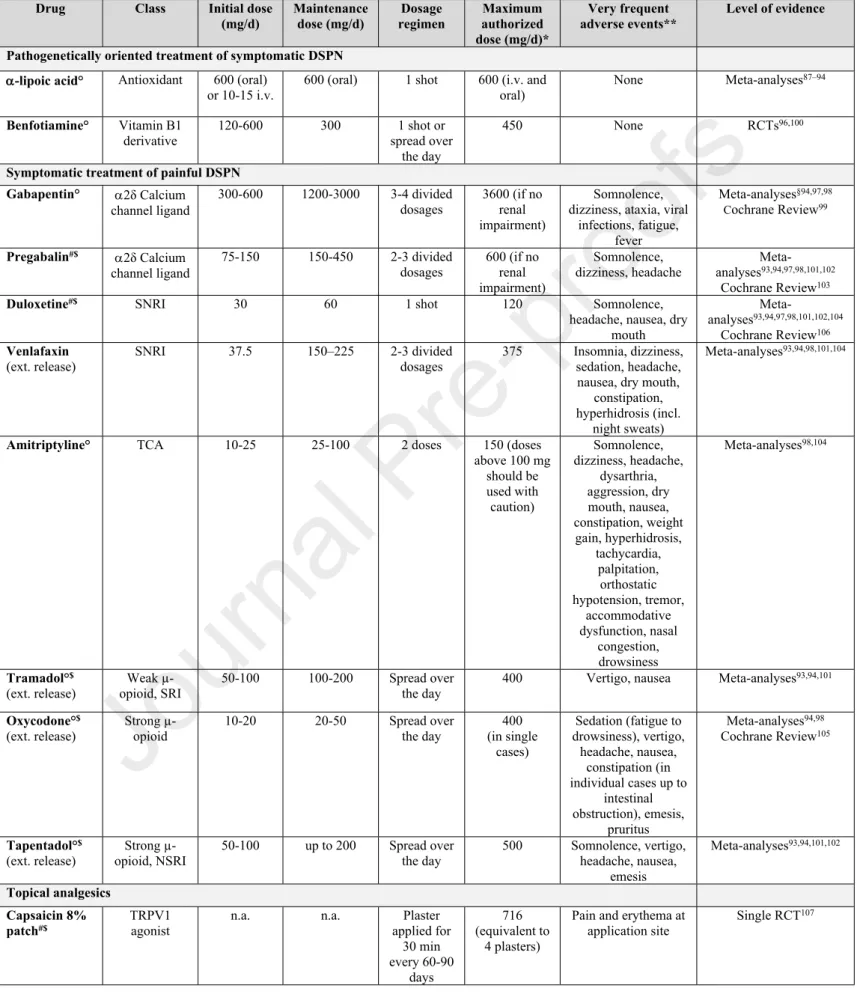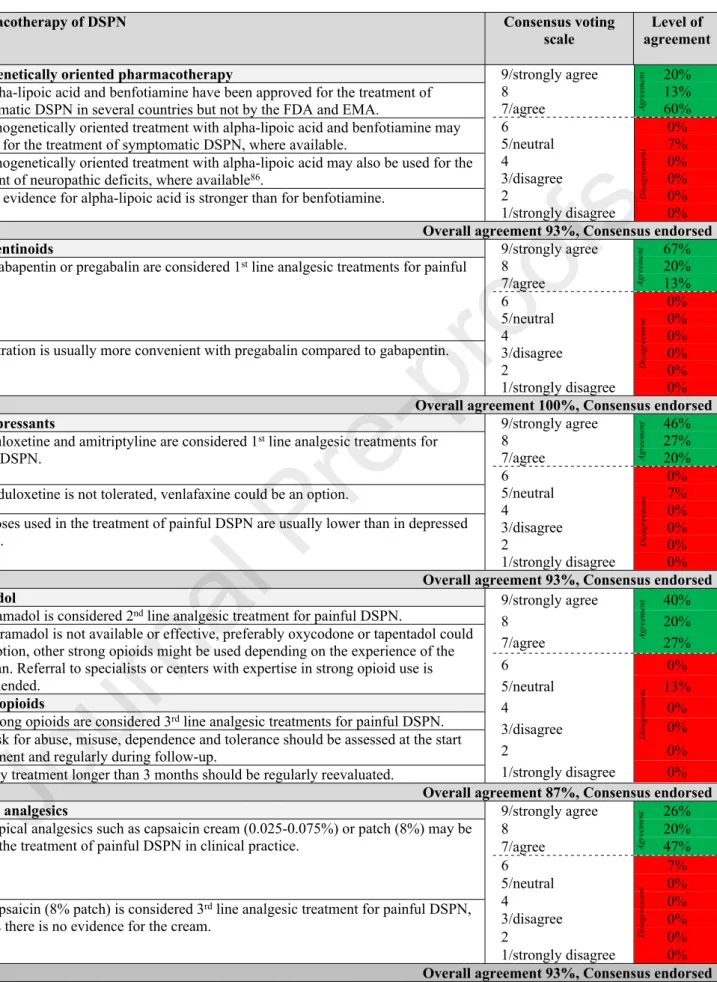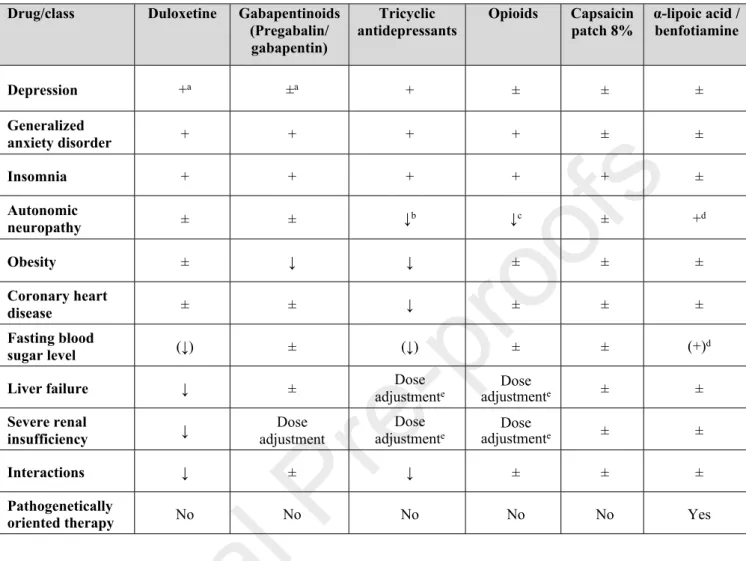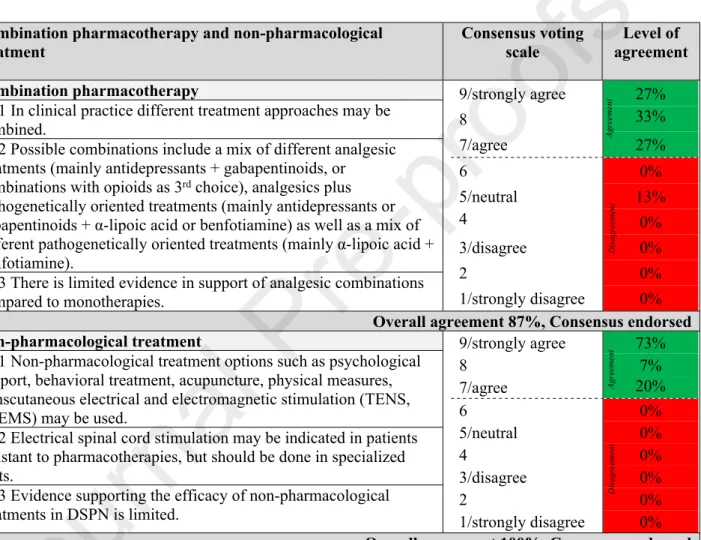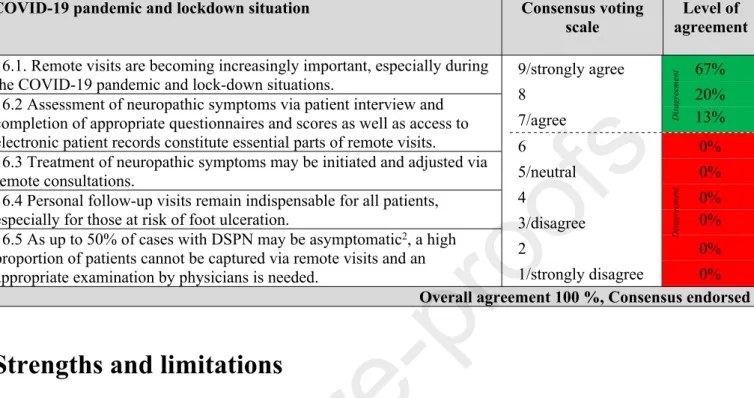Review
Screening, diagnosis and management of diabetic sensorimotor polyneurop- athy in clinical practice: International expert consensus recommendations Dan Ziegler, Solomon Tesfaye, Vincenza Spallone, Irina Gurieva, Juma Al Kaabi, Boris Mankovsky, Emil Martinka, Gabriela Radulian, Khue Thy Nguyen, Alin O Stirban, Tsvetalina Tankova, Tamás Varkonyi, Roy Freeman, Péter Kempler, Andrew JM Boulton
PII: S0168-8227(21)00422-8
DOI: https://doi.org/10.1016/j.diabres.2021.109063
Reference: DIAB 109063
To appear in: Diabetes Research and Clinical Practice Received Date: 28 June 2021
Revised Date: 10 September 2021 Accepted Date: 14 September 2021
Please cite this article as: D. Ziegler, S. Tesfaye, V. Spallone, I. Gurieva, J. Al Kaabi, B. Mankovsky, E.
Martinka, G. Radulian, K. Thy Nguyen, A.O. Stirban, T. Tankova, T. Varkonyi, R. Freeman, P. Kempler, A. JM Boulton, Screening, diagnosis and management of diabetic sensorimotor polyneuropathy in clinical practice:
International expert consensus recommendations, Diabetes Research and Clinical Practice (2021), doi: https://
doi.org/10.1016/j.diabres.2021.109063
This is a PDF file of an article that has undergone enhancements after acceptance, such as the addition of a cover page and metadata, and formatting for readability, but it is not yet the definitive version of record. This version will undergo additional copyediting, typesetting and review before it is published in its final form, but we are providing this version to give early visibility of the article. Please note that, during the production process, errors may be discovered which could affect the content, and all legal disclaimers that apply to the journal pertain.
© 2021 Published by Elsevier B.V.
polyneuropathy in clinical practice: International expert consensus recommendations
Dan Ziegler1,2 Solomon Tesfaye3, Vincenza Spallone4, Irina Gurieva5,6, Juma Al Kaabi7,8, Boris Mankovsky9, Emil Martinka10,11, Gabriela Radulian12, Khue Thy Nguyen13, Alin O Stirban14, Tsvetalina Tankova15, Tamás Varkonyi16, Roy Freeman17, Péter Kempler18, Andrew JM Boulton19
1Institute for Clinical Diabetology, German Diabetes Center, Leibniz Center for Diabetes Research at Heinrich Heine University Düsseldorf, Düsseldorf, Germany
2Department of Endocrinology and Diabetology, Medical Faculty and University Hospital Düsseldorf, Heinrich Heine University Düsseldorf, Düsseldorf, Germany
3 Diabetes Research Department, Sheffield Teaching Hospitals NHS Foundation Trust, Sheffield, United Kingdom.
4 Department of Systems Medicine, Endocrinology Section, University of Rome Tor Vergata, Rome, Italy.
5 Department of Endocrinology, Federal Bureau of Medical and Social Expertise, Moscow, Russia.
6 Department of Endocrinology, Russian Medical Academy of Continuous Professional Education, Moscow, Russia
7 Zayed Centre for Health Sciences, United Arab Emirates University, Al Ain, UAE.
8 Department of Internal Medicine, College of Medicine and Health Sciences, United Arab Emirates University, Al Ain, Abu Dhabi, UAE.
9 Department of Diabetology, National Medical Academy for Postgraduate Education, Kiev, Ukraine.
10 National Institute of Endocrinology and Diabetology, Lubochna, Slovak Republic.
11 Faculty of Health Sciences University of Ss. Cyril and Methodius in Trnava, Slovak Republic.
12 "N. Paulescu" National Institute of Diabetes, Nutrition and Metabolic Diseases, University of Medicine and Pharmacy "Carol Davila" Bucharest, Romania.
13 Ho Chi Minh City University of Medicine and Pharmacy, Ho Chi Minh City, Vietnam.
14 Asklepios Klinik Birkenwerder, Birkenwerder, Germany.
15 Department of Endocrinology, Medical University - Sofia, Sofia, Bulgaria.
16 Department of Internal Medicine, Faculty of Medicine, University of Szeged, Szeged, Hungary.
17 Department of Neurology, Harvard Medical School, Boston, MA, United States.
18 Department of Internal Medicine and Oncology, Semmelweis University, Budapest, Hungary.
19 Faculty of Biology, Medicine and Health, University of Manchester and Manchester University Foundation Trust, Manchester, UK.
Corresponding author:
Prof. Dan Ziegler, MD, FRCPE Institute for Clinical Diabetology
German Diabetes Center at Heinrich Heine University Auf'm Hennekamp 65
40225 Düsseldorf Germany
Tel: +49-211-33820, Fax: +49-211-3382244 Email: dan.ziegler@ddz.de
Abstract
Diabetic sensorimotor polyneuropathy (DSPN) affects around one third of people with diabetes and accounts for considerable morbidity, increased risk of mortality, reduced quality of life, and increased health care costs resulting particularly from neuropathic pain and foot ulcers. Painful DSPN is encountered in 13-26% of diabetes patients, while up to 50% of patients with DSPN may be asymptomatic. Unfortunately, DSPN still remains inadequately diagnosed and treated. Herein we provide international expert consensus recommendations and algorithms for screening, diagnosis, and treatment of DSPN in clinical practice derived from a Delphi process. Typical neuropathic symptoms include pain, paresthesias, and numbness particularly in the feet and calves. Clinical diagnosis of DSPN is based on neuropathic symptoms and signs (deficits). Management of DSPN includes three cornerstones: 1.) lifestyle modification, optimal diabetes treatment aimed at near- normoglycemia, and multifactorial cardiovascular risk intervention, 2.) pathogenetically oriented pharmacotherapy (e.g. α-lipoic acid and benfotiamine), and 3.) symptomatic treatment of neuropathic pain including analgesic pharmacotherapy (antidepressants, anticonvulsants, opioids, capsaicin 8% patch and combinations, if required) and non- pharmacological options. Considering the individual risk profile, pain management should not only aim at pain relief, but also allow for improvement in quality of sleep, functionality, and general quality of life.
Keywords: Diabetic polyneuropathy, neuropathic pain, screening, diagnosis, treatment, guidelines.
Introduction
Diabetic neuropathy represents a condition that develops in the context of diabetes and cannot be attributed to other causes of peripheral neuropathy1–3. It manifests in the somatic and/or autonomic components of the peripheral nervous system. Diabetic sensorimotor polyneuropathy (DSPN) is the commonest form affecting approximately one third of people with diabetes, while its yearly incidence amounts to approximately 2%4. DSPN has been defined as a symmetrical, length-dependent sensorimotor polyneuropathy attributable to metabolic and microvessel alterations as a result of chronic hyperglycemia exposure (diabetes) and cardiovascular risk covariates5. A simpler DSPN definition for clinical practice is the presence of symptoms and/or signs of peripheral nerve dysfunction in people with diabetes after the exclusion of other causes2,3. Chronic peripheral neuropathic pain has been defined as persistent or recurrent pain lasting ≥3 months caused by a lesion or disease of the peripheral somatosensory nervous system6. Neuropathic pain due to diabetes has been defined as pain arising as a direct consequence of abnormalities in the somatosensory system in people with diabetes after exclusion of other causes7. Chronic painful DSPN is encountered in up to one fourth of people with diabetes4. Measures of DSPN have been identified as predictors of all-cause mortality and future neuropathic foot ulcerations as well as cardiovascular morbidity and mortality8–10. In the DIAD study, both sensory deficits and neuropathic pain were independent predictors of cardiac death or nonfatal myocardial infarction11. A community-based study from the UK, showed that reduced pressure sensation to a 10 g monofilament predicted cardiovascular morbidity12. In the ACCORD trial, a history of DSPN was the most important predictor for increased mortality in type 2 diabetes individuals receiving highly intensive diabetes therapy aimed at HbA1c <6.0%13. A retrospective cohort study showed an increased risk of vascular events and mortality in type 2 diabetes patients with painful compared to those with non-painful DSPN14 and in an
epidemiological survey peripheral neuropathy was found to be common and independently associated with mortality in the U.S. population both with and without diabetes.15
Despite its major impact on morbidity and mortality, DSPN remains an underestimated condition by physicians and patients alike. In a German population-based survey, 77% of the cases with DSPN were unaware of having the disorder, defined as answering "no" to the question "Has a physician ever told you that you are suffering from nerve damage, neuropathy, polyneuropathy, or diabetic foot?". Approximately one quarter of the subjects with known diabetes had never undergone a foot examination16. In a German educational initiative, painful and painless DSPN were previously undiagnosed in 57 and 82%
of the participants with type 2 diabetes, respectively17. Likewise, in cross-sectional studies in Qatar, 80% of type 2 diabetes patients with DSPN reported that they had previously not been diagnosed with or treated for this condition18,19. Underdiagnosis and hence underestimation of DSPN was also frequent in South-East Asia, possibly due to a lack of consensus on screening and diagnostic procedures20. Indeed, it has recently been reasoned that the challenge in most countries in this region is that even simple diagnostic tools such as the tuning fork are only available in a specialist setting20. Among U.S. physicians using a 10g monofilament, only 31 and 66% were able to correctly identify mild/moderate and severe DSPN, respectively21.
A population-based survey from Germany revealed that only 38% of patients with painful DSPN (i.e. with average pain level during the past 4 weeks ≥4 on the numeric pain rating scale with 0 indicating no pain and 10 indicating worst pain imaginable) received medical treatment which comprised predominantly nonsteroidal anti‐inflammatory drugs for which efficacy has not been demonstrated in neuropathic pain conditions22. Underdiagnosis and under-/mistreatment of DSPN in clinical practice may be related to a poor acceptance of guidelines. A survey among German family practitioners indicated that only 51% were clearly positive about guidelines and considered them to provide benefits for patient care.
Implementation of clinical guidelines is often perceived as complicated and/or restricting the freedom of action for physicians23.
The aim of the present report originating from an International Consensus Conference on diagnosis and treatment of diabetic sensorimotor polyneuropathy in clinical practice which took place virtually on 11th and 12th of November 2020 on the occasion of the World Diabetes Day is to provide clear, condensed, comprehensive and practical recommendations and algorithms for the screening, diagnosis and treatment of DSPN in clinical practice.
Consensus finding process
A panel of 15 experts comprising 14 diabetologists and 1 neurologist was selected for their contributions and specific expertise in the field of diabetic neuropathy including the chair (DZ) and three co-chairs (AJMB, PK, ST). More specifically, the participants were selected (1) to represent different geographical regions in the EU, UK, Eastern Europe, Russia, Middle East, Asia, and United States, (2) based on their position as key opinion leaders and chair functions in national and international medical associations, and (3) given their previous contributions to international consensus panels. Around half of the participants had contributed to the Toronto Consensus Panel on Diabetic Neuropathy (AJMB, RF, PK, ST, VS, TV, DZ), while three participants coauthored the Position Statement of the American Diabetes Association (AJMB, RF, DZ). The final list of invited experts was aligned among the chairmen before the participants were officially invited.
During the consensus finding process, experts shared their personal clinical experience and routine in diagnosing and treating DSPN and examined the recent literature and current guidelines to provide consensus recommendations and define algorithms for screening, diagnosis and treatment of DSPN that are relevant specifically for clinical practice. The aim was to derive consensus recommendations from published data, where available, using a
hierarchical approach considering evidence from systematic reviews, meta-analyses, and single RCTs and to utilize the participating experts’ own clinical experience where evidence from clinical trials is lacking. To reach a consensus, the Delphi method was applied which is a structured communication technique where a panel of experts answers questionnaires in ≥2 rounds24. The number of voting rounds was not prespecified as the intention was to reach a consensus on each topic.
The first Delphi round was conducted via SurveyMonkey® before the conference comprising qualitative open-ended as well as „tick-box style“ questions (see supplement 1) which were developed and aligned among the chairmen before the link was provided to all participants. The aim of the survey was to gather information about invited experts’ clinical practice and derive drafts for consensus recommendations and algorithms. The drafts were then discussed among and adjusted by the experts during the conference which was organized by Wörwag Pharma according to the instructions by the chairmen. The second Delphi round was also conducted via SurveyMonkey® directly after the conference and included a voting on the finetuned statements and algorithms. A 9-point scale with the following numeric and descriptive anchors was used to measure agreement: strongly disagree (1), disagree (3), neutral (5), agree (7), and strongly agree (9). Ratings of ≤6 were considered as
“disagreement” and ratings of ≥7 were considered as “agreement”. A consensus was defined a priori based on ≥75% of participants agreeing with the statement/algorithm. This approach is based on the results of a systematic review by Diamond et al. which reported a median threshold for finding a consensus at 75% (range: 50-97%) in Delphi studies24. For each statement and algorithm, the level of agreement is presented as the percentage vote of 15 experts.
Implementation of guidelines into clinical practice
In general, the main reasons for introducing clinical practice guidelines are to improve the quality of medical care and reduce health care disparities25. Guidelines for the screening, diagnosis and management of DSPN are of particular interest for both general practitioners and specialists, due to the high prevalence of the condition, its socioeconomic and health impact, the interdisciplinary nature, the need to weigh the potential risks against the proven benefits of a treatment for individual patients, and to make the best use of available resources26. Existing guidelines focusing on painful DSPN or neuropathic pain in general show inconsistencies as to their recommendations of pharmacotherapies as 1st, 2nd and 3rd line treatments2,27–35 (Table 1), which may lower their credibility and create confusion26. The same applies to systematic reviews which are frequently inconclusive36. Conclusiveness of evidence was higher in systematic reviews which included more participants and randomized controlled trials (RCTs), searched more databases, conducted meta-analysis, and examined the quality of evidence37.
Table 1. Recent guidelines for pharmacotherapy of painful diabetic sensorimotor polyneuropathy (DSPN) and neuropathic pain in general.
Painful DSPN Neuropathic pain
ADA (US) 20172
IDF 201727
AAN (US) 201128
Canada 201829
DDG (Germany)
202130
NeuPSIG 201531
France 202032
NICE (UK) 2013/20&33
JSPC (Japan) 201834
EFNS 201035 Tricyclic
antidepressants 1 1 2 2 1 1 1 NC 1 1
Duloxetine 1 1 2 2 1 1 1 1 1 1
Venlafaxine 1 NC 2 2 NC 1 1 NR NR 1
Gabapentin 1 1 2 2 1 1 1 1 1 1
Pregabalin 1 1 1 1 1 1 2$ 1 1 1
Sodium channel
blockers NC NC NC 2+ NC NR NR NR NC NR
Tramadol 3 2 2 3 1 2 2§ NR 2 2/3
Opioids
3# 2 2 3 2 3** 3 NR 3 2/3
Capsaicin 8%
patch NC NC 2 NC 1 2 2§ NR NC NC
Lidocaine 5%
patch NC NC NC NC NC 2 1*** NC NR NC
α-Lipoic acid NR 1*/2* NC NC 1 NC NC NC NC NC
Footnotes/Abbreviations: 1 = 1st line; 2 = 2nd line; 3 = 3rd line; NR = not recommended;
NC = not considered; *intravenously, +valproate, #oxycodone not recommended, **tapentadol inconclusive, §weak recommendation, &non-specialist settings, ***focal pain; ADA:
American Diabetes Association, IDF: International Diabetes Federation, AAN: American Academy of Neurology, DDG: German Diabetes Association, NeuPSIG: Neuropathic Pain Special Interest Group of the International Association for the Study of Pain (IASP), NICE:
National Institute for Health and Care Excellence, JSPC: Japanese Society of Pain Clinicians, EFNS: European Association of Neurological Societies
For various pain conditions including painful DSPN, treatment adherence to published pain management guidelines was associated with lower proportions of hospitalizations, emergency department visits, and lower health care costs38. In the population-based Australian Diabetes, Obesity, and Lifestyle Study (AusDiab), 77% of participants with diabetes reported an eye examination within the previous 2 years, whereas only 50% reported that their feet were examined by a health care professional in the previous year39. Visiting a diabetes nurse in the past 12 months was an independent predictor of a foot examination. A single education session about foot examination for nurses resulted in an increase in the
number of foot examinations by nurses in people with diabetes40. A practical approach to increase the frequency of routine foot examinations in patients with diabetes may be the incorporation into eye screening appointments. Such “one-stop” annual diabetes microvascular screening program has been shown to be feasible and well received by patients and staff alike41–43. A systematic review and meta-analysis of 14 studies revealed that different health education programs may help to increase foot self-care scores and reduce foot problems in people with diabetes44. On the other hand, the reported use of practice guidelines may not necessarily exert a measurable effect towards the intended reduction of health care disparities in patients with DSPN, but rather precipitate more clinical actions potentially contributing to increased cost of medical care as an unintended consequence 25. Thus, further research is needed to better understand the unintended consequences of implementing clinical practice guidelines.
The consensus recommendations for the implementation of guidelines into clinical practice are given in Table 2.
Table 2: Consensus recommendations for the implementation of guidelines for diabetic sensorimotor polyneuropathy (DSPN) into clinical practice.
Implementation of guidelines into clinical practice Consensus voting scale
Level of agreement 1.1 Guidelines should be clearer on diagnostic procedures, adequate
treatment choices, dosing, and follow-up to encourage adoption into clinical practice.
1.2 To ensure implementation of screening procedures even in the absence of neuropathic symptoms, risk assessment for
cardiovascular and other risk factors as well as diagnosis and adequate treatment of DSPN into clinical practice, it is necessary to increase awareness and improve education about the disease among patients emphasizing their active role, health care practitioners, physicians, and relevant stake holders.
1.3 For time efficient routines in clinical practice, DSPN screening may be performed by trained staff such as nurses, diabetes
educators or podiatrists and may be incorporated into e.g. eye screening or other routine procedures.
1.4 A risk-based approach including screening for micro- and macrovascular complications should be applied.
9/strongly agree 67%
8 13%
7/agree 20%
6 0%
5/neutral 0%
4 0%
3/disagree 0%
2 0%
1/strongly disagree 0%
Overall agreement 100 %, Consensus endorsed
Clinical characteristics of DSPN
DSPN usually manifests as a length-dependent distal-symmetrical, sensorimotor polyneuropathy. The most important underlying factors include age, height, obesity, hypertension, smoking, poor glycemic control, diabetes duration, hypoinsulinemia, and an adverse lipid profile5. DSPN is commonly but not invariably associated with autonomic involvement2, may commence insidiously, and if intervention is not successful, it becomes progressive and chronic2. Lower-limb long axons appear more amenable to injury2 and therefore DSPN clinically usually develops first in the feet. Subsequently, it progresses proximally and may also include the upper limbs. This corresponds to a “dying-back” type of axonal degeneration and patients typically present with a so-called “stocking-glove” like distribution of neuronal dysfunction45.
Sensory nerve fiber involvement causes “positive“ symptoms46 such as pain, paresthesias, or dysesthesias as well as “negative“ symptoms (signs, deficits) detectable as
DisagreementAgreement
hypoesthesia including different sensory modalities relating to small (temperature, pain) and large fiber function (touch, pressure, vibration, position) and ataxic gait. However, this differentiation may be difficult for a symptom like “numbness” which can be classified as negative if the patient means a deficit of feeling without spontaneous symptoms or as positive if an asleep-numbness “like a hand that has gone asleep” is meant46. Remarkably, up to 50%
of affected subjects do not report symptoms2,3. Conversely, up to one fourth of people with diabetes develop painful DSPN4.
Screening and diagnosis of DSPN
The basic neurological assessment comprises the general medical and neurological history, inspection of the feet, and neurological examination using simple semi-quantitative bedside instruments2.
Patient history and assessment of neuropathic symptoms and signs
Neuropathic symptoms include pain, characteristically described as burning, painful cold, lancinating, tingling, stabbing or shooting (electric shock–like), as well as non-painful neuropathic symptoms like paresthesias (tingling, prickling or ant-like sensations), dysesthesias (unpleasant abnormal sensation whether spontaneous or evoked), sensory ataxia (ataxic gait) or numbness (often described as “wrapped in wool” or like “walking on thick socks”)2. Neuropathic pain may be accompanied by hyperalgesia (exaggerated response to painful stimuli) and allodynia (pain triggered by normally non-painful stimuli such as the contact of socks, shoes, or bedclothes). Neuropathic pain typically worsens at night and may interfere with daily activities and reduce the quality of life and sleep2. In addition to simple orientating questions, the “Douleur Neuropathique en 4 Questions” (DN4-Interview) may serve as a useful tool to screen for neuropathic pain in diabetes and may constitute a component in the assessment of painful DSPN in clinical practice26,47,48.
Neuropathic symptoms may reflect different pathophysiology rather than signs, e.g.
pain or paraesthesias may be related to the degree of compensatory regeneration rather than to the degree of nerve fiber damage. Moreover, symptoms may have a heterogeneous long-term course with progression and regression to a similar extent49. Screening tools for neuropathic pain may offer guidance for further diagnostic evaluation and pain management but do not replace clinical judgment.50. The intensity (severity) of neuropathic pain and its course can be assessed using an 11-point numeric rating scale (Likert scale) or a visual analogue scale.
Accumulating evidence indicates that the risk of polyneuropathy is increased in prediabetes51. In the general population of Augsburg, Southern Germany, the prevalence of polyneuropathy was 28% among subjects with known diabetes, 13% among those with impaired glucose tolerance (IGT) and 11% among those with impaired fasting glucose (IFG), while it was 7% among those with normal glucose tolerance (NGT)52. The corresponding prevalence rates of painful polyneuropathy were 13, 9, 4, and 1%53. Thus, screening of patients with prediabetes reporting symptoms of DSPN should be considered in clinical practice2.
Small and large nerve fiber damage most frequently coexist in DSPN. Conclusive evidence from prospective studies for the postulated progression from early involvement of small fibers (inducing pain and/or dysesthesias as first symptoms) to later large-fiber dysfunction is missing45,49,54. In contrast, there is evidence in patients recently diagnosed with type 2 diabetes suggesting that parallel damage to small and large nerve fibers occurs early in the course of diabetes55. Hence, testing both small and large nerve fiber function with appropriate bedside tests is equally important.
The clinical examination of DSPN includes the use of semi-quantitative bedside instruments45. In clinical practice, assessment of large sensory nerve fiber function mainly comprises the measurement of vibration sensation (Rydel-Seiffer tuning fork or an alternative vibrating instrument), position sense (proprioception), and touch/pressure perception (e.g.
with 10g monofilament or alternatively the Ipswich touch test)2,45,56–58. Since vibration sensation declines physiologically with age, it is important to consider age-dependent normative values (lower limits for normal sensation using the Rydel-Seiffer tuning fork on the dorsal aspect of the hallux are 5/8 for age ≤39, 4.5/8 for age 40-59, 4/8 for age 60-74, 3.5/8 for age ≥75 years)56. When an automated device such as the Biothesiometer, Neurothesiometer, Maxivibrometer, Vibrameter, Vibratron or CASE IV System is used to quantitatively measure vibration perception threshold59, age-related reference values provided by the manufacturer can be applied. If the monofilament test is applied to the dorsum of the big toe, it identifies DSPN. If applied to the sole of the foot, it may also be used to identify patients with high ulceration risk2,60. Small nerve fiber function can be assessed in clinical practice primarily by testing pain/sharp sensation (pinprick) and temperature discrimination2,45,61,62. Tools for assessment of autonomic small nerve fiber function such as the Neuropad® indicator test to determine cutaneous sweat production63 or Sudoscan® to measure electrochemical skin conductance64 may be used, but these devices were applied by the panel too infrequently in clinical practice to allow for a representative statement (see supplement 2).
Differential diagnosis
The following findings should alert the physician to consider causes for DSPN other than diabetes and trigger referral for a detailed neurological work-up: 1) predominant motor rather than sensory deficits, 2) pronounced asymmetry of the neurological deficits, 3) rapid development or progression of symptoms or deficits 4) mononeuropathy and cranial nerve involvement, 5) progression of the neuropathy despite optimizing glycemic control, 6) onset of symptoms and deficits in the upper limbs, 7) family history of non-diabetic neuropathy, 8) neurological findings exceeding those typical for DSPN, and 9.) diagnosis of DSPN cannot be ascertained by clinical examination with the aforementioned semi-quantitative bedside tests63.
The most important differential diagnoses from the general medicine perspective include neuropathies caused by alcohol abuse, uremia, hypothyroidism, monoclonal gammopathy, vitamin B12 deficiency, paraproteinemias, peripheral arterial disease, cancer, inflammatory and infectious diseases, and neurotoxic drugs. Differential diagnosis of DSPN should also consider that the causes may vary between different countries as well as urban and rural areas20. A meta-analysis found that diabetes patients treated with metformin had an increased risk of vitamin B12 deficiency showing dose- and duration-dependent reductions of serum vitamin B12 concentrations65. Annual assessment of the vitamin B12 status in people with diabetes treated with metformin was suggested65.
The consensus recommendations for screening, clinical diagnosis, and differential diagnosis of DSPN are listed in Table 3.
Table 3: Consensus recommendations for screening, clinical diagnosis, and differential diagnosis of DSPN.
Screening and diagnosis Consensus voting
scale
Level of agreement Screening
2.1 Patient history should encompass neuropathic pain
characteristics, assessment of pain severity and interference with daily activities and sleep.
2.2 For screening or identification of neuropathic pain
characteristics, appropriate questionnaires such as DN4 may be used.
2.3Patient history should encompass non-painful symptoms (e.g.
paresthesias, numbness, sensory distortion).
2.4 For clinical diagnosis of DSPN in practice, validated scores for neuropathic symptoms (e.g. NSS) and signs (e.g. NDS, MNSI-E) may be used.
9/strongly agree 53%
8 13%
7/agree 34%
6 0%
5/neutral 0%
4 0%
3/disagree 0%
2 0%
1/strongly disagree 0%
Overall agreement 100%, Consensus endorsed Clinical diagnosis
3.1 Bilateral impairment of vibration sensation with tuning fork (large fiber) and/or pinprick test (small fiber) may be appropriate as minimal criteria for diagnosis of DSPN in clinical practice.
3.2 The presence of neuropathic pain and signs of DSPN in the same distribution is suggestive of painful DSPN.
3.3 Neuropathic pain in a plausible neuroanatomical distribution, i.e. distal symmetrical, may occur in the absence of a clinically evident DSPN.
3.4 A single abnormal screening test bilaterally suggests the presence of DSPN and may require a more extended diagnostic workup.
9/strongly agree 40%
8 13%
7/agree 47%
6 0%
5/neutral 0%
4 0%
3/disagree 0%
2 0%
1/strongly disagree 0%
Overall agreement 100%, Consensus endorsed Differential diagnosis
4.1 Consider other causes of polyneuropathy, e.g. drug-induced, by history.
4.2 Assessment of vitamin B12, serum protein electrophoresis, eGFR, TSH, blood count, magnesium and liver enzymes may be advisable.
4.3 In addition, assessment of vitamin D status may be advisable.
4.4 Consider referral to neurologist where appropriate.
9/strongly agree 46%
8 27%
7/agree 20%
6 0%
5/neutral 0%
4 0%
3/disagree 7%
2 0%
1/strongly disagree 0%
Overall agreement 93%, Consensus endorsed Footnotes/abbreviations: DSPN: diabetic sensorimotor polyneuropathy; DN4: “Douleur Neuropathique en 4 Questions”; NSS: Neuropathy Symptom Score; NDS: Neuropathy Disability Score; MNSI-E: Michigan Neuropathy Screening Instrument Examination part;
eGFR: estimated glomerular filtration rate; TSH: Thyroid-stimulating hormone.
The consensus recommendations for the individual modalities of sensory examination are shown in Table 4. Notably, clear evidence and detailed guidance on how to perform the semi- quantitative bedside tests and assess their results is often lacking in the literature.
AgreementAgreementDisagreementAgreementDisagreementDisagreement
Table 4: Consensus recommendations for sensory examination in diabetic sensorimotor polyneuropathy (DSPN).
Sensory examination Consensus voting
scale
Level of agreement Vibration sensation
5.1 Vibration sensation may be tested using a tuning fork.
5.2 The dorsal big toe (interphalangeal joint) constitutes the primary examination site.
5.3 When using a Rydel-Seiffer tuning fork, age-dependent thresholds according to Martina et al. 1998 are available56.
5.4 For automated devices, thresholds provided by the manufacturer are applicable.
5.5 If a calibrated tuning fork is not available, a simpler vibrating tool or tuning fork using an “on-off” or double-dummy technique with mock- applications may be used60.
9/strongly agree 73%
8 20%
7/agree 7%
6 0%
5/neutral 0%
4 0%
3/disagree 0%
2 0%
1/strongly disagree 0%
Overall agreement 100%, Consensus endorsed Pressure/touch sensation
6.1 Pressure/touch sensation may be tested using a 10g monofilament or cotton wool/Q-tip or tissue.
6.2 This test can identify DSPN and feet at high risk of ulceration depending on the application site.
6.3 For identification of DSPN:
- The dorsum of the big toe constitutes the primary examination site60. - Pressure/touch sensation is considered impaired if in total ≥5 out of 8 contacts (4 per foot) are not sensed by the patient60.
6.4 In resource-limited situations the Ipswich touch test may be an alternative57,58.
6.5 Allodynia can be assessed with a cotton wool/Q-tip, soft brush or tissue and by asking the patient if the stimulus provokes a painful sensation.
9/strongly agree 40%
8 27%
7/agree 33%
6 0%
5/neutral 0%
4 0%
3/disagree 0%
2 0%
1/strongly disagree 0%
Overall agreement 100%, Consensus endorsed Pain/sharp sensation
7.1 Pain or sharp sensation may be tested using a NeurotipTM/Neuropen®, pinprick or similar.
7.2 The dorsal side of the big toe and foot constitutes the primary examination site.
7.3 Pain sensation is considered impaired if ≥2 out of 3 contacts per foot are not perceived as “painful” by the patient.
7.4 Painful areas may be tested for hyperalgesia.
9/strongly agree 60%
8 20%
7/agree 13%
6 0%
5/neutral 0%
4 7%
3/disagree 0%
2 0%
1/strongly disagree 0%
Overall agreement 93%, Consensus endorsed Temperature sensation
8.1 Temperature sensation may be tested using a Tiptherm®, cold tuning fork or similar.
8.2 The dorsal side of the foot and big toe constitute the primary examination sites.
8.3 Temperature sensation is considered impaired if ≥2 out of 3 contacts per foot are not correctly discriminated.
9/strongly agree 52%
8 7%
7/agree 27%
6 0%
5/neutral 0%
4 0%
3/disagree 7%
2 7%
1/strongly disagree 0%
Overall agreement 86%, Consensus endorsed
AgreementDisagreementAgreementAgreementDisagreementAgreementDisagreementDisagreement
For standardized assessment of the severity of both neuropathic symptoms and signs, various scores may be used, which vary with respect to their individual components66–73 (Table 5).
Table 5. Scores for assessment of neuropathic symptoms and signs.
Score NSS66 TSS67 NTSS-668 mTCNS69 NDS66 MNSI-E70 UENS71
Neuropathic symptoms X X X X - - -
Burning X X X X
Tingling/prickling X X X X
Numbness/insensitivity X X X X
Weakness X - - X
Cramps X - - -
Ataxia - - - X
Pain/aching/tightness X X X X
Sharp, shooting, lancinating pain - - X -
Allodynia/hyperalgesia - - X -
Upper limb symptoms - - - X
Neuropathic signs - - - X X X X
Foot inspection/ulcers - - X -
Ankle reflex - X X X
Muscle strength - - - X
Proprioception X - - X
Vibration sensation (tuning fork) X X X X
Pressure sensation (10 g monofilament) - - Xa -
Light touch sensation X - - -
Pain sensation X X - X
Allodynia/hyperesthesia - - - X
Temperature sensation X X - -
Validation of score No No Yes68 Yes69,72 No Yesa 70,72,73 Yes71,72
Threshold for DSPN (points) ≥3* No ≥6 ≥3 ≥3* ≥2.5 ≥3
Footnotes/abbreviations: X included in score; - not included in score; NSS: Neuropathy Symptom Score; TSS: Total Symptom Score; NTSS-6: Neuropathy Total Symptom Score-6;
NDS: Neuropathy Disability Score; MNSI-E: Michigan Neuropathy Screening Instrument Examination part; mTCNS: Modified Toronto Clinical Neuropathy Score; UENS: Utah Early Neuropathy Scale; a validated before monofilament test was included in the score; DSPN:
diabetic sensorimotor polyneuropathy; * minimum acceptable criteria for diagnosis of DSPN were defined as NDS≥6 with or without NSS≥3 or NDS≥3 with NSS≥6.
To facilitate the physician’s decisions, algorithms for screening, diagnosis, and management of DSPN in clinical practice were developed (Figures 1-3). The corresponding levels of agreement are summarized in Table 6.
Table 6: Levels of agreement for algorithms for screening, diagnosis and management of diabetic sensorimotor polyneuropathy (DSPN) in clinical practice as depicted in Figures 1-3
Figure 1
Screening and diagnosing DSPN in clinical practice
Figure 2
Choice of treatment options for DSPN in clinical practice
Figure 3
Analgesic pharmacotherapy and non-pharmacological treatment
options in painful DSPN Consensus voting
scale
Level of agreement
Consensus voting scale
Level of agreement
Consensus voting scale
Level of agreement 9/strongly agree 46%
8 27%
7/agree 20%
6 0%
5/neutral 0%
4 0%
3/disagree 7%
2 0%
1/strongly disagree 0%
9/strongly agree 33%
8 40%
7/agree 13%
6 7%
5/neutral 0%
4 0%
3/disagree 0%
2 7%
1/strongly disagree 0%
9/strongly agree 39%
8 27%
7/agree 27%
6 7%
5/neutral 0%
4 0%
3/disagree 0%
2 0%
1/strongly disagree 0%
Overall agreement 93%, Consensus endorsed
Overall agreement 86%, Consensus endorsed
Overall agreement 93%, Consensus endorsed
The consensus recommendation for an algorithm to screen for and diagnose DSPN in clinical practice is shown in Fig. 1.
Treatment of DSPN and neuropathic pain
There are three major principles in the management of DSPN: 1) optimal diabetes treatment including lifestyle modification, intensive glucose control and multifactorial cardiovascular risk intervention, 2) pathogenetically oriented pharmacotherapy, and 3) symptomatic pain relief.
Causal treatment
In the large Look AHEAD study including overweight or obese participants with type 2 diabetes, a less prominent increase in neuropathic symptoms, but not neuropathic signs was observed in the group receiving an intensive lifestyle intervention program focusing on weight loss through reduced caloric intake and increased physical activity compared with the
AgreementDisagreement
AgreementDisagreement
AgreementDisagreement
control group that was assigned to a diabetes support and education program74. The DCCT/EDIC study demonstrated that intensive insulin therapy aimed at achieving near- normal glycemia is essential to prevent, albeit not completely, or delay progression of DSPN in patients with type 1 diabetes. However, there is no convincing evidence in type 2 diabetes patients to suggest that intensive diabetes therapy has a favorable effect on the development or progression of DSPN. The Steno 2 Study assessed the effect of multifactorial cardiovascular risk intervention on diabetic complications, but could not demonstrate a favorable effect on DSPN75–77 . Nonetheless, there is general agreement that glucose control should be optimized to prevent or slow the progression of DSPN in people both with type 1 and type 2 diabetes2.
Pathogenetically oriented pharmacotherapy
The pathogenesis of diabetic neuropathy is multifactorial78. Hyperglycemia and dyslipidemia result in a substrate excess in mitochondria leading to mitochondrial dysfunction and overproduction of reactive oxygen species (ROS) and reactive carbonyls. ROS and carbonyl stress-mediated nuclear DNA damage activates poly(ADP-ribose) polymerase-1 (PARP1). Upstream inhibition of key glycolytic enzymes by oxidative stress activates major pathways implicated in the development of diabetic neuropathy: polyol pathway, hexosamine pathway, protein kinase C (PKC) activity, and advanced glycation end products (AGEs) pathway79. Based on these pathogenetic mechanisms, pharmacotherapies have been introduced to favorably influence the underlying neuropathic process rather than for symptomatic pain treatment80.
For clinical use, the antioxidant -lipoic acid and the thiamine derivative (prodrug) and AGE inhibitor benfotiamine are licensed as drugs and approved for treatment of DSPN in several countries worldwide81,82. Actovegin, a deproteinized ultrafiltrate of calf blood and
poly(ADP-ribose) polymerase (PARP) inhibitor, is authorized mainly in Russia and eastern European countries, while the aldose reductase inhibitor epalrestat is marketed only in Japan and India83,84. Several meta-analyses demonstrated that infusions of -lipoic acid (600 mg i.v./day) ameliorated neuropathic symptoms and deficits (signs, impairments) after 3 weeks.
Moreover, treatment for 5 weeks and 6 months using -lipoic acid 600 mg QD and BID orally, respectively, reduced the main symptoms of DSPN including pain, paresthesias, and numbness82,85–94. In the NATHAN 1 trial, neuropathic deficits were improved after 4 years in patients with mild to moderate largely asymptomatic DSPN86. By contrast, vitamin E (mixed tocotrienols) as another antioxidant did not reduce neuropathic symptoms after 1 year of treatment95. The BENDIP study showed that neuropathic symptoms, with NSS as the primary endpoint, were improved after 6 weeks of treatment using a benfotiamine dose of 300 mg BID but not 300 mg QD96. Additional long-term RCTs could further strengthen the rationale for use in clinical practice. Both -lipoic acid and benfotiamine, have favorable safety profiles even during long-term treatment. An overview on the usual dosages, most frequent adverse events, and scientific evidence is given in Table 787–94,96–107.
Table 7. Dosages, adverse events and scientific evidence of pharmacotherapies used in the management of DSPN in clinical practice
Drug Class Initial dose
(mg/d)
Maintenance dose (mg/d)
Dosage regimen
Maximum authorized dose (mg/d)*
Very frequent adverse events**
Level of evidence
Pathogenetically oriented treatment of symptomatic DSPN
-lipoic acid° Antioxidant 600 (oral)
or 10-15 i.v. 600 (oral) 1 shot 600 (i.v. and
oral) None Meta-analyses87–94
Benfotiamine° Vitamin B1
derivative 120-600 300 1 shot or
spread over the day
450 None RCTs96,100
Symptomatic treatment of painful DSPN Gabapentin° 2δ Calcium
channel ligand
300-600 1200-3000 3-4 divided dosages
3600 (if no renal impairment)
Somnolence, dizziness, ataxia, viral
infections, fatigue, fever
Meta-analyses§94,97,98 Cochrane Review99
Pregabalin#$ 2δ Calcium channel ligand
75-150 150-450 2-3 divided dosages
600 (if no renal impairment)
Somnolence, dizziness, headache
Meta- analyses93,94,97,98,101,102
Cochrane Review103
Duloxetine#$ SNRI 30 60 1 shot 120 Somnolence,
headache, nausea, dry mouth
Meta-
analyses93,94,97,98,101,102,104
Cochrane Review106 Venlafaxin
(ext. release) SNRI 37.5 150–225 2-3 divided
dosages 375 Insomnia, dizziness, sedation, headache, nausea, dry mouth,
constipation, hyperhidrosis (incl.
night sweats)
Meta-analyses93,94,98,101,104
Amitriptyline° TCA 10-25 25-100 2 doses 150 (doses
above 100 mg should be used with caution)
Somnolence, dizziness, headache,
dysarthria, aggression, dry mouth, nausea, constipation, weight gain, hyperhidrosis,
tachycardia, palpitation,
orthostatic hypotension, tremor,
accommodative dysfunction, nasal
congestion, drowsiness
Meta-analyses98,104
Tramadol°$ (ext. release)
Weak µ- opioid, SRI
50-100 100-200 Spread over the day
400 Vertigo, nausea Meta-analyses93,94,101
Oxycodone°$ (ext. release)
Strong µ- opioid
10-20 20-50 Spread over
the day
400 (in single
cases)
Sedation (fatigue to drowsiness), vertigo,
headache, nausea, constipation (in individual cases up to
intestinal obstruction), emesis,
pruritus
Meta-analyses94,98 Cochrane Review105
Tapentadol°$ (ext. release)
Strong µ- opioid, NSRI
50-100 up to 200 Spread over the day
500 Somnolence, vertigo, headache, nausea,
emesis
Meta-analyses93,94,101,102
Topical analgesics Capsaicin 8%
patch#$
TRPV1 agonist
n.a. n.a. Plaster
applied for 30 min every 60-90
days
716 (equivalent to
4 plasters)
Pain and erythema at application site
Single RCT107
Footnotes/Abbreviations: ° National authorizations for treatment of DSPN; # Authorization by the European Medicine Agency (EMA) for the treatment of (neuropathic) pain or painful DSPN; $ Authorization by the U.S. Food and Drug Administration (FDA) for the treatment of (neuropathic) pain or painful DSPN; * based on Summary of Product Characteristics (SPCs) of originator products according to EMA or the Federal Institute for Drugs and Medical Devices in Germany (BfArM); ** Frequency of events ≥1/10 according to SPCs of originator products by EMA or BfArM; §mixed results; DSPN: diabetic sensorimotor polyneuropathy;
i.v.: intravenous; n.a.: not applicable; RCTs: randomized controlled trials. TRPV1: Transient receptor potential vanilloid-1; SRI: Serontinin reuptake inhibitors; SNRI: serotonin- norepinephrine reuptake inhibitors; TCA: tricyclic antidepressants
The consensus recommendations for pathogenetically oriented pharmacotherapy of DSPN are summarized in Table 8.
Table 8: Consensus recommendations for pharmacotherapy of DSPN.
Pharmacotherapy of DSPN Consensus voting
scale Level of agreement Pathogenetically oriented pharmacotherapy
9.1 Alpha-lipoic acid and benfotiamine have been approved for the treatment of symptomatic DSPN in several countries but not by the FDA and EMA.
9.2 Pathogenetically oriented treatment with alpha-lipoic acid and benfotiamine may be used for the treatment of symptomatic DSPN, where available.
9.3 Pathogenetically oriented treatment with alpha-lipoic acid may also be used for the treatment of neuropathic deficits, where available86.
9.4 The evidence for alpha-lipoic acid is stronger than for benfotiamine.
9/strongly agree 20%
8 13%
7/agree 60%
6 0%
5/neutral 7%
4 0%
3/disagree 0%
2 0%
1/strongly disagree 0%
Overall agreement 93%, Consensus endorsed Gabapentinoids
10. 1 Gabapentin or pregabalin are considered 1st line analgesic treatments for painful DSPN.
10.2 Titration is usually more convenient with pregabalin compared to gabapentin.
9/strongly agree 67%
8 20%
7/agree 13%
6 0%
5/neutral 0%
4 0%
3/disagree 0%
2 0%
1/strongly disagree 0%
Overall agreement 100%, Consensus endorsed Antidepressants
11.1 Duloxetine and amitriptyline are considered 1st line analgesic treatments for painful DSPN.
11.2 If duloxetine is not tolerated, venlafaxine could be an option.
11.3 Doses used in the treatment of painful DSPN are usually lower than in depressed patients.
9/strongly agree 46%
8 27%
7/agree 20%
6 0%
5/neutral 7%
4 0%
3/disagree 0%
2 0%
1/strongly disagree 0%
Overall agreement 93%, Consensus endorsed Tramadol
12.1 Tramadol is considered 2nd line analgesic treatment for painful DSPN.
12.2 If tramadol is not available or effective, preferably oxycodone or tapentadol could be an option, other strong opioids might be used depending on the experience of the physician. Referral to specialists or centers with expertise in strong opioid use is recommended.
Strong opioids
12.3 Strong opioids are considered 3rd line analgesic treatments for painful DSPN.
12.4 Risk for abuse, misuse, dependence and tolerance should be assessed at the start of treatment and regularly during follow-up.
12.5 Any treatment longer than 3 months should be regularly reevaluated.
9/strongly agree 40%
8 20%
7/agree 27%
6 0%
5/neutral 13%
4 0%
3/disagree 0%
2 0%
1/strongly disagree 0%
Overall agreement 87%, Consensus endorsed Topical analgesics
13.1 Topical analgesics such as capsaicin cream (0.025-0.075%) or patch (8%) may be used in the treatment of painful DSPN in clinical practice.
13.2 Capsaicin (8% patch) is considered 3rd line analgesic treatment for painful DSPN, whereas there is no evidence for the cream.
9/strongly agree 26%
8 20%
7/agree 47%
6 7%
5/neutral 0%
4 0%
3/disagree 0%
2 0%
1/strongly disagree 0%
Overall agreement 93%, Consensus endorsed
Footnotes/Abbreviations: EMA: European Medicine Agency; FDA: U.S. Food and Drug Administration; DSPN: diabetic sensorimotor polyneuropathy.
AgreementAgreementDisagreementAgreementDisagreementAgreementDisagreementAgreementDisagreementDisagreement
